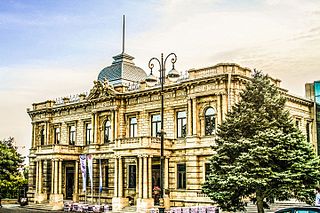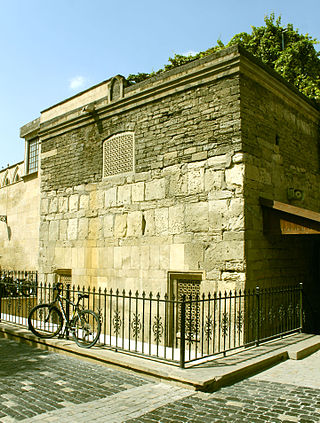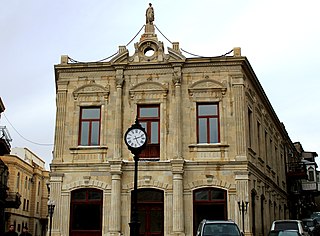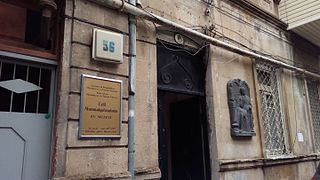Rinay is a malacological museum of natural history in Baku, Azerbaijan. It is also the first private museum in the country.

Azerbaijan National Museum of Art is the biggest art museum of Azerbaijan. It was founded in 1936 in Baku and in 1943 was named after Rustam Mustafayev, a prominent Azerbaijani scenic designer and theater artist. The museum consists of two 19th century buildings standing next to each other. The museum's total collection includes over 15,000 artworks. There are over 3,000 items in 60 rooms on permanent display. About 12,000 items are kept in storage. The museum changes the exhibits periodically so that more of these artworks can be displayed temporarily.

The Ashura Mosque is a mosque in Baku, Azerbaijan. It was founded in 1169 by the master Najaf Ashur son of Ibrahim. It is located in the Asaf Zeynalli Street. The mosque is frequently called the ‘Lezgin Mosque’. The second name of the mosque is connected with the oil boom of the 19th century. As a result of this event, a large inflow of labour was observed in Baku, including from Dagestan. This mosque was used by Lezgin workers during religious ceremonies.

Azerbaijan National Carpet Museum is a museum located in Baku that displays Azerbaijani carpets and rugs with historical and modern weaving techniques and materials. It has the largest collection of Azerbaijani carpets in the world. First opened on Neftchiler Avenue in 1967, it moved to a new building on the Baku's seafront park in 2014.

The Ministry of Culture of Azerbaijan Republic is a governmental agency within the Cabinet of Azerbaijan in charge of regulation of the activities and promotion of Azerbaijani culture. The ministry is headed by Anar Karimov.

The National Flag Square is a large city square off Neftchiler Avenue in Bayil, Baku, Azerbaijan. The National Flag Square covers 60 hectares overall. The area of the upper part is 3 hectares. The square features the state symbols of Azerbaijan—the coat of arms and the anthem—and a map of the country.

The Independence Museum of Azerbaijan or "Istiqlal" Museum – is a museum established on 7 December 1919 in Baku – the capital of the Azerbaijan Democratic Republic. H. Mirzajamalov and I. M. Aghaoglu had a great role in the creation of the museum. Archeological finds, exemplars of rare books, objects of numismatics, jewelry, etc. were collected in the museum.

Ganja State History-Ethnography Museum named after Nizami Ganjavi is the largest museum in Ganja,

The Hasanbey Zardabi Natural History Museum is a natural history museum in Baku, Azerbaijan.

Bukhara Caravanserai is a caravanserai located in Baku, Azerbaijan. It was erected in the late 15th century over a trade route passing through the Shamakhi Gates of the fortress. It is located in the Icherisheher old town, opposite the Multani Caravanserai, and close to the Maiden Tower. The caravanserai was harnessed as a hotel, basically catering to merchants of Central Asia.

The Multani Caravanserai is a caravanserai located in Baku, Azerbaijan. It was established in the 14th century and is located in the Icherisheher old town, opposite the Bukhara Caravanserai.

The Small Cravanserai in Baku, Azerbaijan has a square shape and an inner quadrangular courtyard with cut corners. This caravanserai was built in the 12th century. There is a long balcony which surrounds the building of the caravanserai. The north and south entrances of the caravanserai are portal-shaped. During the Middle Ages, there was a main entrance from the sea. The caravanserai has a defensive construction and two floors on the southern side.

The Gasim bey Bath, built in the 17th century, is a medieval monument of national importance. Also named Sweet Bath for the sweets served to bathers with their tea, it is located near the Salyan gates of the fortress, Icheri Sheher, Azerbaijan.

The Agha Mikayil Bath was erected in the 18th century in the south-western part of the fortress, on one of its main streets, Kichik Gala, Old City where local people frequently call this place the neighborhood of bath amateurs.

The Museum of Archaeology and Ethnography is a museum in Baku, Azerbaijan, that was established in 1976. It bears the name of the Azerbaijani architect-Mikayil Huseynov. The museum has two parts. The ethnography section displays materials related to the 19th century and early 20th century, as well as the life of Azerbaijani people.

The House-Museum of Nariman Narimanov was opened in Baku, Azerbaijan, on November 6, 1977. Nariman Narimanov lived in the apartment together with his family during 1913–1918.

The house-museum of Jalil Mammadguluzadeh is a memorial museum of the famous Azerbaijani journalist, enlightener, writer-satirist, Jalil Mammadguluzadeh. The museum is located on Suleyman Taghizade Street, in the city of Baku, where the writer lived during 1920–1932.

The Museum Center of the Ministry of Culture and Tourism of the Republic of Azerbaijan is a building located in Baku, Azerbaijan near Boulevard. The classical and conceptual art exhibitions of modern Azerbaijan, anniversary and personal exhibitions of famous artists, debut creativity of new artists are demonstrated here.

Gunay Zebic (Mehdizade) (Azerbaijani: Günay Mehdizadə; born on June 18, 1981, Baku city) is an Azerbaijani painter and a member of the Union of Artists of Azerbaijan, artist of Turkey and Azerbaijan, author and organizer of the project of the Art Gymnasium within the Bursa Zaki Muren Fine Arts Lyceum and Azerbaijan National Conservatory. She is the author and organizer of Bursa Zeki Müren Fine Arts Lyceum and "Brother School" project of the Art Gymnasium within the National Conservatory of Azerbaijan, as well as author of portrait of Atatürk, exhibited at the house-museum of Atatürk in Ankara.


















